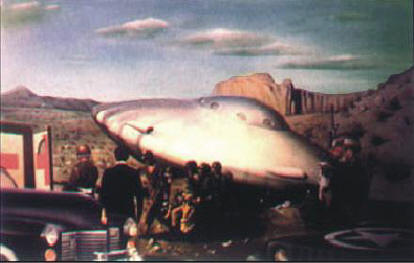






| Website Stats |
Visits from over |
|
Free downloads |
You can now read the material from this website on most electronic devices: -On your computer
Two NEW books from the author of BibleHelp
|
UFOs: Fact or Fiction? (Part 1 of 8)
Back

Picture drawn by Vincent Dumond
Chapter: 11.07
(Section 11: Understanding God and His Universe)
Copyright © Michael Bronson 1997, 1999, and 2000
BibleHelp.org
Summary
Are UFOs real of just a figment of an overactive imagination. Read the next 8 chapters to learn some things that you may have never thoughts about.
Click Here for a book version of this material
Do I believe in UFOs? Yes. Do I believe these UFOs are space ships from other planets? No. UFO, of course, stands for Unidentified Flying Object. This means a UFO is any object in the sky we can’t identify. "Unidentified" means just that; unidentified. So, when I say that I believe in UFOs, I’m saying that I believe people see things in the sky they can’t identify.
I realize some people automatically equate "UFOs" with flying saucers, but they are not the same. They shouldn’t be used interchangeably. If we know something is a flying saucer, it stops being "unidentified" and it becomes a "flying saucer." So, instead of asking people if they believe in UFOs, we should be asking them if they believe these mysterious sightings are flying saucers from other planets.
In my previous chapter (Is There Life on Other Planets?) I talked about why I do not believe there is extraterrestrial life out there. Of course, any study on extraterrestrial life is not complete without talking about "UFOs." Therefore, I have written these chapters to cover a couple major points concerning this subject.
Unfortunately, it is very difficult to adequately cover the subject of UFOs because of abuses on both sides of the issue. The military and government have greatly fueled suspicions and mistrust by their arrogant secrecy on issues that didn’t need to be kept secret. On the other hand, many authors have deliberately sensationalized this subject with misleading or false information in order to sell more books and gain recognition.
As a result, the issue has become completely mired in a tangled web of secrets, conspiracies, and lies. It would be a monumental task to try to unwind this tangled mess and, quite frankly, it wouldn’t be worth my time or yours to try. Therefore, this chapter will not address individual UFO sightings. Rather, I’m going to present two fundamental reasons that have led me to believe that flying saucers cannot be visiting our planet.
The first reason I don’t think we are being visited by extraterrestrial life is because I don’t believe there is extraterrestrial life out there. The previous chapter (Is There Life on Other Planets?) covers this in detail. The second reason I don’t think we are being visited by flying saucers is because I don’t believe interstellar travel (travel between stars) is physically realistic. Even if there is extraterrestrial life out there, I don’t think they could make it to our planet.
In the 1800s it was commonly believed that most stars had planets inhabited with life. In fact, Will Herschel (the man who discovered Uranus) even thought that the sun itself was inhabited with life. People assumed it was only a matter of time before we would be visited by extraterrestrials. Orson Welles, in his infamous 1939 radio broadcast, War of the Worlds, convinced many people that Martians were invading Earth. His broadcast was so convincing that some people actually committed suicide out of fear. Although he was not the first to write about space aliens, he did sensationalize the subject and was the inspiration of many other science fiction books.
For most of the last two centuries, scientists assumed our neighboring planets could support life. Then, in the mid 1900s, they began to realize this wasn’t the case. New technological advancements gave researchers their first comprehensive look at these planets. They discovered that the environments on these planets are far too hostile to support life. As a result, scientists have turned their attention to the stars in their search for extraterrestrial life.
As I mentioned earlier, I don’t believe UFOs are flying saucers from outer space because I think it would be very impractical for extraterrestrials (if they exist) to make fly-by visits to our world. There are six major reasons I feel interstellar travel is physically unrealistic. They are:
Distances are too great. If we could travel 10 times faster than our fastest spaceship, it would still take us 8,200 years to reach our closest star.
Ultra high-speeds are impossible. To propel a spaceship the size of NASA’s space shuttle to 50% of the speed of light, it would take energy equal to 23 million atomic bombs. This estimate does not even include the weight of the fuel and rockets needed to get the shuttle into earth’s orbit (which is 95% of the shuttle’s weight at the time of launch). In fact, this estimate does not include a large number of things that would add weight to the spaceship.
Collision problems. Running into a pebble the size of a pea (while flying at 50% of the speed of light) would produce kinetic energy equal to 2.2 atomic bombs.
Force fields could not protect ultra high-speed spaceship. Even if "force fields" technically could be designed, it would be impossible to supply them the necessary power to protect ultra high-speed spaceships. As stated earlier, hitting a pebble would generate energy equal to 2.2 atomic bombs. Therefore, the energy powering the force field must be at least that great to absorb the impact. In fact, (as the chapter shows) this number needs to be multiplied millions of times for every second of use.
Outer space is anything, but empty. Outer space is full of hidden objects that can completely destroy ultra high-speed spaceships.
Difficulties in detecting objects in its path. Let’s say a spaceship has a "radar" so sensitive that it can detect a rock the size of a TV at 10,000 miles. If it is flying at 50% of the speed of light, the pilot will only have 4/100th of a second to respond.
Difficulties in avoiding objects. In the above scenario, the flight adjustment to avoid the rock would produce 1.8 million Gs of G force. Three Gs will give a fighter pilot red eye and nine Gs can kill him.
The following seven chapters will cover each of these problems in detail. In summary, the slower speeds may be "safer" but they would take too long. The faster speeds may reduce the travel time, but they would be far too dangerous. Even though technology can overcome many obstacles, we still need to be realistic. Interstellar travel makes great science fiction, but it is not scientific.
Footnotes: The footnote section for the UFO chapters has 10 pages of calculations. I have, therefore, put all of the footnotes and calculations on another web page to keep these web pages cleaner looking. Click on the link below to go to the footnotes:
Related Sources:
The Universe and Beyond, (1999) by Terence Dickinson
Endless Universe, (1999) by Heather Couper
Other Worlds, (1999) by James Trefil
Majestic Universe, (1999) by Serge Brunier
Nightwatch, (2000), by Herence Dickinson
Atlas of Deep-sky splendors, (1983) by Hans Vehrenberg
Artificial Space Debris, Johnson and McKnight, p 69
Other Chapters in this Section
Home
Tell a Friend about this page

